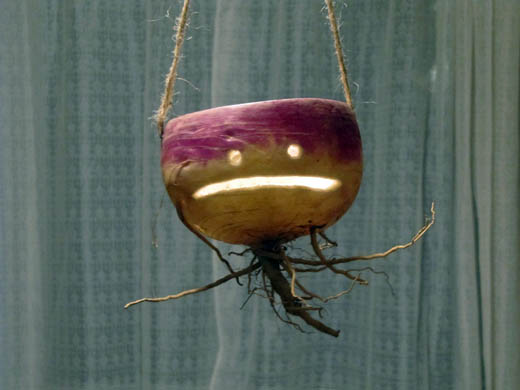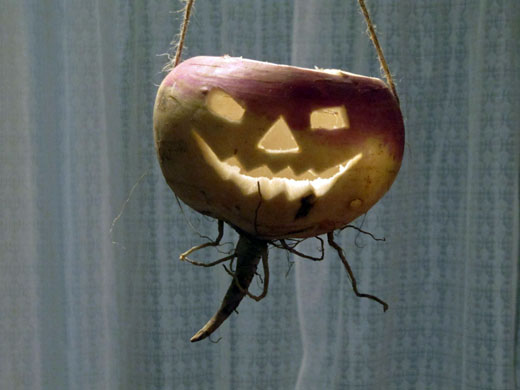American Halloween may be the most medieval of holidays, even if the omnipresence of New World pumpkins obscures its already murky traditions. Most people carve jack-o’-lanterns, for example, without wondering why the heck they’re doing it. The curious can look to Irish folklore, to a tangle of tales about a scoundrel named Jack whose evil deeds keep him out of Heaven but whose tricks sufficiently infuriate the Devil to bar him forever from Hell. With nowhere to go after death, Jack roams the earth, his path lit only by the glow of an ember in a hollowed-out turnip.
Between the eighth-century inception of All Saints’ Day in Rome and the pre-Christian celebrations of Samhain, I see no harm in presuming that the jack-o’-lantern tradition is medieval too. And so last October I turned to my more sensible half and asked her: “Why doesn’t anyone carve turnips anymore?”
As it turns out, Old World jack-o’-lanterns are weirdly easy to make. Cut off the top, scoop out the brains with a melon baller, and use one of those cheap little mini-saws—they’re sold every autumn as pumpkin-carving tools, although they’re nigh-useless on the real thing—to turn a humble, bulbous root into an eerie little sentinel.

We found these—the largest turnips I’ve ever seen—at a roadside produce market out here in the Maryland boonies. The taproots add unexpected spookiness, and the skin is thick enough that you can hang them with a head full of tea-light without worrying that they’ll break and fall.

Should you suffer pumpkin withdrawal, you can easily give your lantern the traditional jagged leer.

So why did lantern-carving immigrants from the British Isles turn in their turnips for all things cucurbita? Some people have suggested that North American turnips tend to be smaller than their New World cousins, and thus harder to carve, but I don’t think that’s it; rather, pumpkins have one clear advantage over hollowed-out turnips. Carved pumpkins can survive with their dignity intact for days or weeks if the weather’s right and squirrels don’t get into them—but our Old World jack-o’-lanterns lasted only two or three days before their little faces wizened into unrecognizability. A damned soul wandering the night for all eternity needs better visibility than that. On the other hand, turnips are faster and safer to carve and much less messy, so we’re happy to light them along our porch as tokens of fleeting glory, retelling a legend the centuries never quite quenched.


Ach, these photos are superb! I shall hie me forth to search out suitable turnips forthwith.
LikeLike
I wish you luck! Just be careful not to scoop out too much of the insides; make sure there’s enough of a “wall” so the whole thing retains its structural integrity. You’ll quickly get a feel for the medium…
LikeLike
Like. We have five giant jack o’ lanterns this year–the traditional, one artistic magical creature, one vomitting seeds, and one poop emoji.
Forty years ago I was biking in a remote part of Ireland in summer and wheeled by a pair of little boys with charcoaled faces carrying turnip lanterns. I can’t remember why they were out, or what date it was.
LikeLike
The poop emoji really is the yellow “have a nice day” face of our age.
Thanks for the Ireland story! If anyone in the British Isles still makes turnip jack-o’-lanterns, I’d be delighted to know. I’m thinking it’s possible that someone over there is going to look at this blog post and wonder what it is I’m fussing about.
LikeLike
It did feel as if we had fallen into another century.
LikeLike
Wonderful! I’d often wondered about turnip lanterns, and assumed they must just be harder work to carve than pumpkins, but these are much more earthy and satisfying somehow, I agree about the tap root.
The Breton writer Per Jakez Helias, in his memoir ‘The Horse of Pride’ (Le cheval d’orgueil), about growing up in the early years of the 20th century in the Bigouden area of SW Brittany, tells how they used to carve turnip lanterns there around Toussaint, and how one time a group of the boys ran through the village on home-made stilts with the lit up lanterns on their heads chanting something from the liturgy and scaring everyone to death! They were quite an isolated community, presumably didn’t take the custom from either Ireland or the New World, so it must have come from an authentic older Celtic tradition.
LikeLike
Thanks for telling me about that, Lucy! Yes, it’s almost certainly a cognate tradition—how neat. (I know from reading about Gauguin that Brittany is a world and a culture unto itself.)
For what it’s worth, we had a hard time finding suitably sized turnips this year. A local farmer told us it just wasn’t a good season for them. We carved four anyway, and they were cute, but they lacked the dramatic and evocative taproots of these guys from last year.
LikeLike